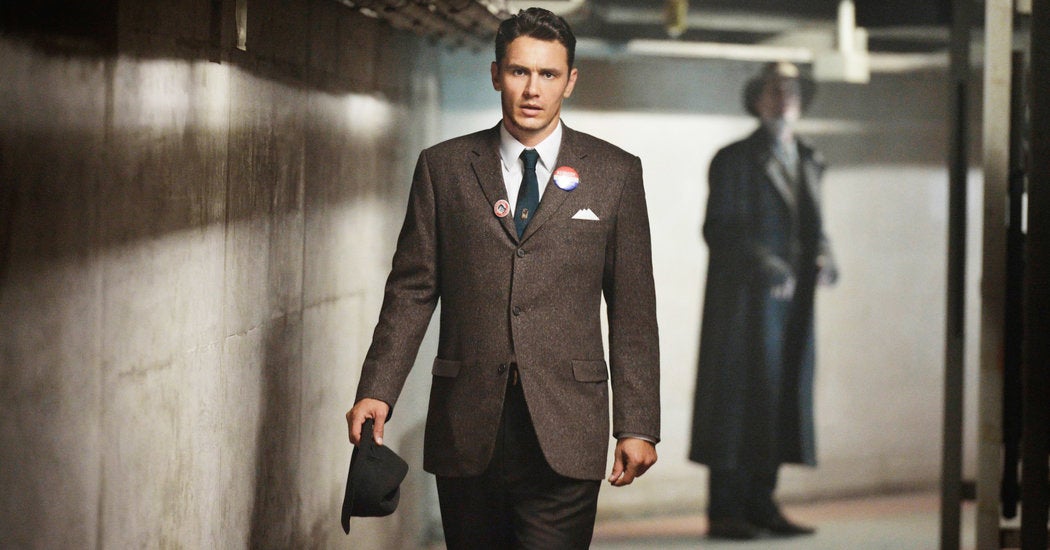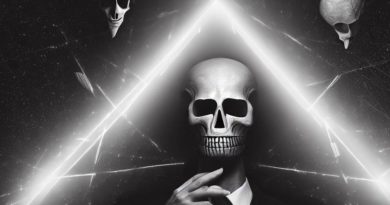In Movies, Books and TV, a Rabbit Hole of Kennedy Conspiracies

Presidents’ Day promises the usual array of thematic TV diversions: historical documentaries, basic cable marathons, James Franco traveling through time to stop the Kennedy assassination.
In the Hulu series “11.22.63,” based on the 2011 novel by Stephen King and debuting Feb. 15, Mr. Franco stars as Jake, a teacher who is shown a wormhole to 1960 and uses it to try to thwart Lee Harvey Oswald.
The murder of President John F. Kennedy has captivated artists and audiences for five decades, and it’s easy to see why. It is a narrative gold mine: epoch-defining tragedy, political intrigue, true crime and a motley cast of characters who range from the handsome and heroic leader of the Western world to the runty outcast who (we’re told) killed him in Dallas. One could spend from now until October 2017, when the final remaining records on the assassination are scheduled to be released, wallowing in J.F.K. metafiction and not reach the end.
Here is a small sample of the offerings, most from the ’90s J.F.K.-conspiracy mini-craze, organized loosely by culprit.
AMERICA
“I shouted out, ‘Who killed the Kennedys?’/When after all, it was you and me.”
— The Rolling Stones, “Sympathy for the Devil”
‘AMERICAN TABLOID’
James Ellroy’s sprawling historical crime novel, acclaimed upon its release in 1995, posits that the assassination was not the moment America lost its innocence, as the cliché has it, because America was never innocent. As with Mr. Ellroy’s more straightforward crime novels, like “L.A. Confidential,” the story focuses mostly on the mercenary acts of a few behind-the-scenes operators, whose collaborators included, but were not limited to, the Feds, the Kennedy family, the mafia, Jimmy Hoffa and Howard Hughes. Their high-level blackmailing, heroin stealing and Bay of Pigs-militia training amounts to a dark secret history of the mid-20th century. The novel, the first in the author’s “Underworld USA” trilogy, ends as the motorcade roles inexorably into Dealey Plaza. But by then, you’re wondering how J.F.K. lasted as long as he did.
What about Oswald? He’s mostly a non-factor.
LONE GUNMEN
“Oh, Marina, Marina, it’s cold and it’s lonely/When you’re pointing a gun at the president.”
— Cowboy Junkies, “The Truth About Us (The Ballad of Lee And Marina)”
‘QUANTUM LEAP’: ‘LEE HARVEY OSWALD’
The series, in which Sam Beckett (Scott Bakula) traveled through time by inhabiting other people’s bodies, broke format in its two-part 1992 fifth season premiere by having its hero leap into the body of an actual historical figure: Oswald. After he fails to prevent the assassination, it is revealed that his true mission was to save Jackie Kennedy, which he did by leaping into the body of Clint Hill. (That Secret Service agent famously jumped onto the back of the president’s limousine as it left the scene.) The episode was conceived in response to the more fanciful theories of the film “JFK” (see below) and others. Donald P. Bellisario, who created the show, actually met Oswald when they were in the Marines together, and the episode reflected Mr. Bellisario’s belief that Oswald acted on his own. “It’s more comforting to believe in plots,” Dean Stockwell’s Al says in the episode. “Because if Kennedy could be killed that easily by one sicko, what hope is there for the rest of us?”
What about Oswald? He did it.
‘THE X-FILES’: ‘MUSINGS OF A CIGARETTE SMOKING MAN’
This 1996 episode posits the show’s über-villain as a bizarro Forrest Gump, helping to orchestrate many of America’s defining catastrophes, including shooting Kennedy from a Dallas sewer. “Life is like a box of chocolates,” the Smoking Man says. “A cheap, thoughtless, perfunctory gift that nobody ever asks for.”
What about Oswald? He is framed for the murder and actually gives the Smoking Man, a nonsmoker before the Kennedy plot, his first cigarettes.
‘RED DWARF’: ‘TIKKA TO RIDE’
In a 1997 episode of this British cult sci-fi comedy, the titular spaceship’s crew members travel back in time in search of Indian food and end up instead in the Texas School Book Depository, where they inadvertently knock Oswald out of the window and prevent the assassination. A quick time-skip to a few years later reveals that a resulting chain of events, beginning with Kennedy’s impeachment for sharing a mistress with the mob boss Sam Giancana, left the world on the brink of nuclear annihilation. In an inspired solution, they convince Kennedy that to preserve his legacy, he must go back in time with them and assassinate himself.
What about Oswald? He fires two shots but is unwittingly tangential to the murder.
A SHADOWY CABAL
“How do you think that jury made up of putrid mass/Embraced theory of triangle bullet lines/Turning in circles twice, /Then incredible, marvelous, exiting back of mind?”
— The Fall, “Oswald Defense Lawyer”
‘LIBRA’
In his 1988 novel, Don DeLillo weaves together fact and literary invention to create a fictional biography of Oswald. The would-be assassin is not unlike many angry young men of literature: misunderstood, antisocial and emotionally isolated. He becomes a pawn in a plot by ex-C.I.A. operatives to provoke war with Cuba by trying to kill Kennedy. (The plot originally calls for a failed attempt, but another assassin ends up killing the president.) The title refers both to Oswald’s astrological sign and, the author has said, to the fact that a man “could tilt either way.”
What about Oswald? He’s the crux of the whole thing, though, like most of us, a victim of circumstance.
‘JFK’
Oliver Stone’s audacious 1991 thriller featured lurid details — we all remember where we were when we first saw a shirtless, gold-painted Tommy Lee Jones — and an expansive conspiracy that reached into the White House, the Pentagon, organized crime and the intelligence community. Kevin Costner starred as Jim Garrison, the dogged, possibly misguided New Orleans district attorney whose accusations and book, “On the Trail of Assassins,” formed much of the basis of “JFK.” The historical details were widely disputed, but the film’s pastiche of cinematic styles and its rich cast — Jack Lemmon, Walter Matthau and Sissy Spacek are among the co-stars you may have forgotten about — make it a compelling watch to this day.
What about Oswald? As critics noted when the film was released, Oswald was perhaps the only person in the film who didn’t play a role in Kennedy’s death.
‘SEINFELD’: ‘THE BOYFRIEND’
“Seinfeld” wasn’t above a little intertextual parody, and arguably the most memorable example was a two-part episode from 1992 that goofed on “JFK.” In it, Kramer and Newman, who claimed that the Mets’ first baseman Keith Hernandez had spit on them, stood in for Kennedy and Gov. John B. Connally. Jerry Seinfeld was Jim Garrison, the investigator. (Wayne Knight, who starred as Newman, had a role in “JFK.”) The bit added the phrases “magic loogie” and “second spitter” to the show’s voluminous lexicon.
What about Oswald? Mr. Hernandez was cast as the patsy, not that he cares what you think about him. He’s Keith Hernandez.
This article has been archived for your research. The original version from The New York Times can be found here.


